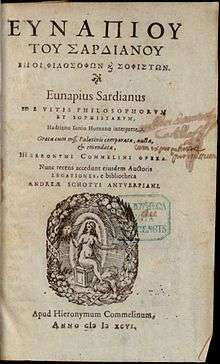Eunapius

Eunapius (Greek: Εὐνάπιος; fl. 4th–5th century AD) was a Greek sophist and historian of the 4th century AD. His principal surviving work is the Lives of Philosophers and Sophists (Greek: Βίοι Φιλοσόφων καὶ Σοφιστῶν; Latin: Vitae sophistarum), a collection of the biographies of 23 philosophers and sophists.
Early life
He was born at Sardis, AD 346. In his native city he studied under his relative, the sophist Chrysanthius, and while still a youth went to Athens, where he became a favourite pupil of Prohaeresius the rhetorician. He possessed considerable knowledge of medicine.
Writing
Eunapius was the author of two works, one entitled Lives of Philosophers and Sophists, and Universal History consisting of a continuation of the history of Dexippus. The former work is still extant; of the latter only excerpts remain, but the facts are largely incorporated in the work of Zosimus. It embraced the history of events from AD 270–404.
The Lives of Philosophers and Sophists, a collection of the biographies of 23 older and contemporary philosophers and sophists of the author, is valuable as the only source for the history of the Neoplatonism of that period. The style of both works is marked by a spirit of bitter hostility to Christianity. Photius had before him a "new edition" of the history in which the passages most offensive to Christians were omitted.
The Lives of Philosophers and Sophists consists of the biographies of the following philosophers and sophists: Plotinus, Porphyry, Iamblichus, Alypius, Sosipatra, Aedesius the Cappadocian, Sopater, Ablabius, Eustathius, Maximus, Priscus, Julian of Cappadocia, Prohaeresius, Epiphanius, Diophantus (Diophantus the Arab), Sopolis, Himerius, Parnacius, Libanius, Acacius, Nymphidianus, Zeno of Cyprus, Magnus, Oribasius, Ionicus and Crysanthius.
Later years
In his later years he seems to have lived at Athens, teaching rhetoric. Initiated into the Eleusinian Mysteries, he was admitted into the college of the Eumolpidae and became hierophant. There is evidence that he was still living in the reign of the younger Theodosius.
References
- Edition of the Lives by JF Boissonade (1822), with notes by D Wyttenbach
- History fragments in C. W. Müller, Fragmenta Hist. Graecorum, iv.
- V. Cousin, Fragments philosophiques (1865), translation: W. C. Wright in the Loeb Classical Library edition of Philostratus's Lives of the Sophists (1921).
 This article incorporates text from a publication now in the public domain: Chisholm, Hugh, ed. (1911). "article name needed". Encyclopædia Britannica (11th ed.). Cambridge University Press.
This article incorporates text from a publication now in the public domain: Chisholm, Hugh, ed. (1911). "article name needed". Encyclopædia Britannica (11th ed.). Cambridge University Press.
Further reading
- Philostratus, Lives of the Sophists. Eunapius, Lives of the Philosophers and Sophists. Translated by Wilmer C. Wright. 1921. Loeb Classical Library. ISBN 978-0-674-99149-1
External links
- English translation of the Lives of the Philosophers and Sophists and Introduction by Wilmer Cave Wright (translator) from the Tertullian Project.
- Greek Opera Omnia by Migne Patrologia Graeca with Analytical Indexes
- Βίοι Φιλοσόφων καὶ Σοφιστῶν (original text in Greek)